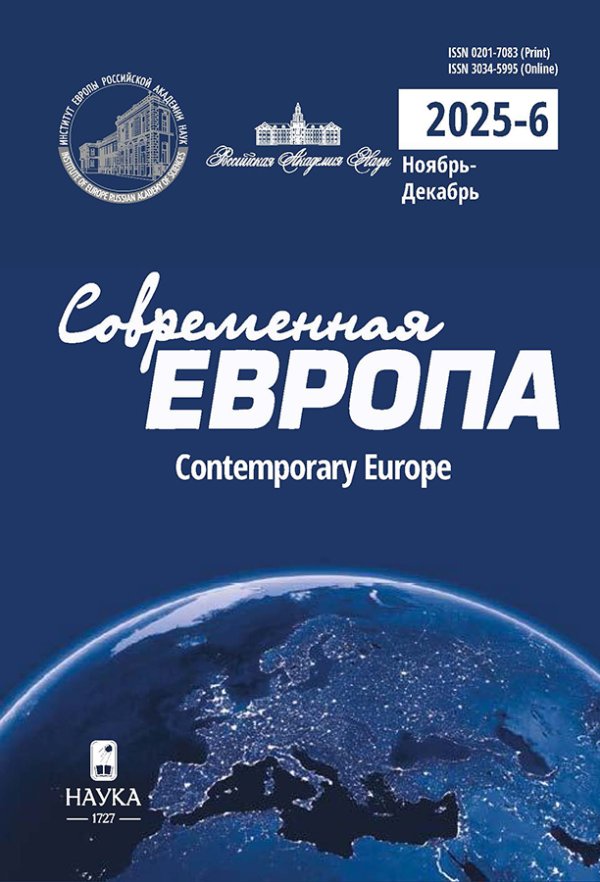Features of hybrid identity of the second/third generation of european muslims
- Authors: Andreeva L.A.1
-
Affiliations:
- Institute for African Studies Russian Academy of Sciences
- Issue: No 4 (118) (2023)
- Pages: 170-182
- Section: Articles
- URL: https://journals.rcsi.science/0201-7083/article/view/142219
- DOI: https://doi.org/10.31857/S0201708323040101
- EDN: https://elibrary.ru/BXGUVO
- ID: 142219
Cite item
Full Text
Abstract
Keywords
About the authors
Larisa Anatol'evna Andreeva
Institute for African Studies Russian Academy of Sciences
Email: larchen1969@gmail.com
Moscow, Russia
References
- Андреева Л.А., Андреева Л.К. (2015) Секулярный или постсекулярный мир? Верификация концепций. Социологические исследования. № 3(371). С. 82-88.
- Андреева Л.А., Следзевский И.В., Смирнов М.Ю. (ред.) (2021) Трансформации глобального конфессионального геопространства: феномен "параллельных" обществ в системе международно-политических отношений. Издательство Владимир Даль, Санкт-Петербург.
- Викторова Е.В. (ред.) (2018) Формирование современной европейской идентичности в рамках интеграции ЕС: социальное и культурное измерения. Изд-во СПбГЭУ, Санкт-Петербург. 167 с.
- Волков Ю.Г., Курбатов В.И. (2022) Гибридная идентичность: факторы формирования и формы проявления. Гуманитарий Юга России. Том 11. № 2. С. 15-26. DOI: https://doi.org/10.18522/2227-8656.2022.2.1
- Деминцева Е. (2008) Быть арабом во Франции. Новое литературное обозрение, Москва. 182 c.
- Мачина А.А. (2018) Гибридная идентичность как фактор политической реальности европейского общества. Вопросы политологии. Вып. 1(29). С. 24-31.
- Сафонова Н.В. (2021) Эволюция интеграционной политики во Франции: причины кризиса. Вестник Московского государственного лингвистического университета. Общественные науки. Вып. 3(844). С. 169-184. doi: 10.52070/2500-347X_2021_3_844_169
- Шумилин А.И. (2021) Республика против политического ислама (часть 1). Научно-аналитический вестник Института Европы РАН. № 1. С. 54-61. DOI: http://dx.doi.org/10.15211/vestnikieran120215461
- Giddens A. (2001) Sociology. Polity Press, Cambridge, UK. 750 p.
- Habermas J. (1996) Die Einbeziehung des Anderen. Studien zur politischen Theorie. Suhrkamp Verlag, Frankfurt am Main, Germany. 404 p.
- Hall S. (1999) Kulturelle Identität und Globalisierung. Widerspenstige Kulturen. Cultural Studies als Herausforderung. Ed. by K.H. Hörning, R. Winter. Suhrkamp Verlag, Frankfurt am Main, Germany. P. 393-441.
- Hein K. (2006) Hybride Identitäten. Transcript Verlag, Bielefeld, Germany. 472 p.
- Hynes L. (2000) Looking for Identity Food, Generation & Hybridity. Australian Screen Education Online. No. 24. P. 30-36.
- Marotte V. (2006) Civilisation, culture and the hybrid self in the work of Robert Ezra Park. Journal of Intercultural Studies. Vol. 27. Issue 4. P. 413-433.
- Schneider I. (1997) Hybridkultur: Medien, Netze, Künste. Wienand, Köln, Germany. 366 p.
- Wagner C. (2016) Migration and the Creation of Hybrid Identity: Chances and Challenges. Proceedings of Harvard Square Symposium, The Phenomenon of Migration, August 22-23, 2016. Research Association for Interdisciplinary Studies. Ed. by I.-G. Rotaru, D.E. Simion, V. Burcea. The Scientific Press, Cambridge, USA. P. 237-255. doi: 10.5281/zenodo.999620
- Yildiz T. (2016) Qui sont-ils? Enquête sur les jeunes musulmans de France. L'artilleur, France. 352 p.
- Young R. (1995) Colonial Desire: Hybridity in Theory, Culture and Race. Routledge, London, UK. 256 p.
Supplementary files










